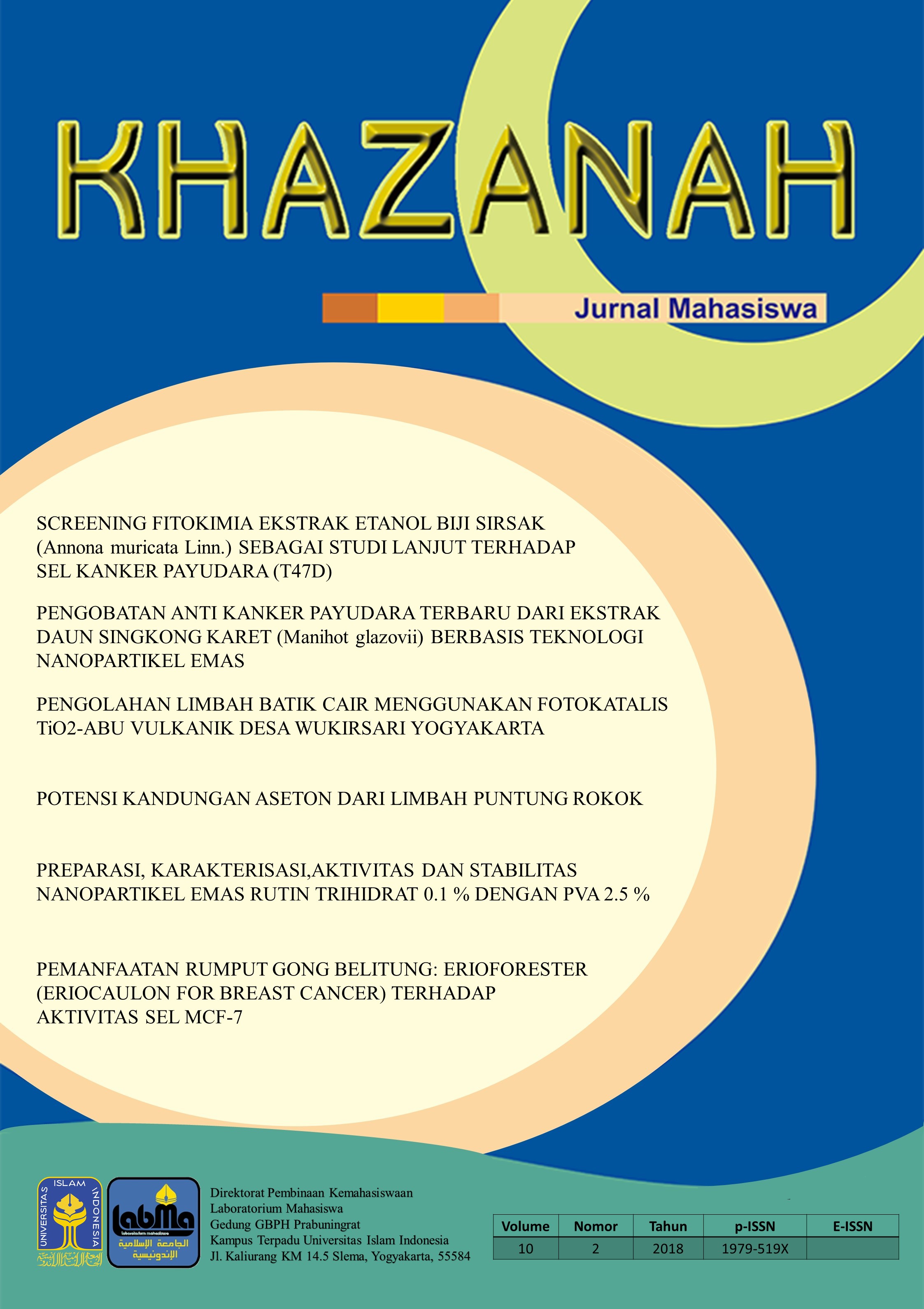Main Article Content
Abstract
Rumput gong (Eriocaulon cinereum R. Br.) secara turun temurun telah digunakan oleh masyarakat Bangka Belitung sebagai terapi kanker. Studi pendahuluan menunjukkan bahwa ekstrak metanol rumput gong memiliki aktivitas sitotoksik terhadap sel kanker serviks. Salah satu spesies lain Eriocaulon, Eriocaulon australe dilaporkan memiliki efek sitotoksisitas terhadap sel kanker MCF-7, Hela dan A549 [3]. Untuk dapat dikembangkan lebih lanjut, suatu agen sitotoksik harus bersifat selektif terhadap sel kanker. Oleh karena itu, penelitian ini bertujuan untuk menguji aktivitas sitotoksik fraksi dari ekstrak metanol rumput gong terhadap sel MCF-7 dan sel Vero, serta mengidentifikasi golongan senyawa yang terkandung dalam fraksi diklorometan dan air. Proses ekstraksi dilakukan dengan Ultrasound-Assisted Extraction dan fraksinasi dilakukan menggunakan metode partisi cair-cair. Uji aktivitas sitotoksik dilakukan menggunakan metode MTT assay dan nilai absorbansi diukur menggunakan ELISA reader pada panjang gelombang 595 nm. Data dianalisis menggunakan metode PROBIT. Hasil uji sitotoksik menunjukkan nilai Inhibition Concentration (IC50) fraksi diklorometan rumput gong terhadap sel MCF-7 adalah 459,86 µg/ml, sedangkan IC50 fraksi air terhadap sel MCF-7 adalah 5473,58 µg/mL. Indeks selektivitas (IS) fraksi diklorometan sebesar 0,74. Hasil analisa selektivitas menunjukkan bahwa fraksi diklorometan kurang selektif pada sel MCF-7. Selanjutnya, nilai IC50 fraksi diklorometan terhadap sel Vero adalah adalah 341,52 µg/mL dan IC50 fraksi air terhadap sel Vero sebesar 5296,78 µg/mL. Identifikasi kandungan senyawa dengan metode kromatografi lapis tipis (KLT) menunjukkan adanya kandungan senyawa golongan alkaloid, steroid, fenolik dan terpenoid pada fraksi diklorometan.
Article Details
License
1. Proposed Policy for Journals That Offer Open Access
Authors who publish with this journal agree to the following terms:- Authors retain copyright and grant the journal right of first publication with the work simultaneously licensed under a Creative Commons Attribution License that allows others to share the work with an acknowledgement of the work's authorship and initial publication in this journal.
- Authors are able to enter into separate, additional contractual arrangements for the non-exclusive distribution of the journal's published version of the work (e.g., post it to an institutional repository or publish it in a book), with an acknowledgement of its initial publication in this journal.
- Authors are permitted and encouraged to post their work online (e.g., in institutional repositories or on their website) prior to and during the submission process, as it can lead to productive exchanges, as well as earlier and greater citation of published work (See The Effect of Open Access).
2. Proposed Policy for Journals That Offer Delayed Open Access
Authors who publish with this journal agree to the following terms:- Authors retain copyright and grant the journal right of first publication, with the work [SPECIFY PERIOD OF TIME] after publication simultaneously licensed under a Creative Commons Attribution License that allows others to share the work with an acknowledgement of the work's authorship and initial publication in this journal.
- Authors are able to enter into separate, additional contractual arrangements for the non-exclusive distribution of the journal's published version of the work (e.g., post it to an institutional repository or publish it in a book), with an acknowledgement of its initial publication in this journal.
- Authors are permitted and encouraged to post their work online (e.g., in institutional repositories or on their website) prior to and during the submission process, as it can lead to productive exchanges, as well as earlier and greater citation of published work (See The Effect of Open Access).
How to Cite
Pratiwi, D. A., Putri, R. K., Komariah, S. N., & Nugraha, A. T. (2020). PEMANFAATAN RUMPUT GONG BELITUNG: ERIOFORESTER (ERIOCAULON FOR BREAST CANCER) TERHADAP AKTIVITAS SEL MCF-7. Khazanah: Jurnal Mahasiswa, 10(2). Retrieved from https://journal.uii.ac.id/khazanah/article/view/16644
